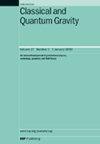引力作为光锥的统计理论
IF 3.6
3区 物理与天体物理
Q2 ASTRONOMY & ASTROPHYSICS
引用次数: 0
摘要
在本文中,我们将探讨Padmanabhan对重力的介观、统计方法(Padmanathan 2017 J. Phys)。: Conf. ser . 880012008)。他的方法的总体图景是,时空是由大量的局域量子自由度组成的。Padmanabhan假设给定几何量子态的自由度,在对波动进行平均后,对某一点的时空有一个矢量自由度。对于零向量,这可以看作对应于光锥上每一点的统计系综的一个单一向量,即纯态。在本文中,我们考虑的情况是,引力自由度的状态是分散和重叠的,它们中的哪一个决定了某一点上的实际时空,只有概率信息。在连续体极限下,这对应于光锥上每一点的统计系综的混合状态。这种假设的变化导致了一些有趣的观察结果。当我们在光锥上定义统计系综时,它的方差“知道”光锥的内部。作为一个有趣的结果,我们发现宇宙常数可以与光锥上的方差有关。对于混合态,我们不能再从熵泛函中推导引力场方程。在这里,我们证明了在变分原理中对光锥上的混合态测度的朴素实现导致了作为大正则系综的修正测度理论,并允许人们将非模引力重新框架为光锥上统计理论的正则系综。本文章由计算机程序翻译,如有差异,请以英文原文为准。
Gravitation as a statistical theory on the light cone
In this paper, we will explore Padmanabhan’s mesoscopic, statistical approach to gravity (Padmanathan 2017 J. Phys.: Conf. Ser.880 012008) with a twist. The general picture of his approach is that spacetime is made of large numbers of localized quantum degrees of freedom. Padmanabhan assumed that the degrees of freedom of a given quantum state of geometry contribute, after averaging over fluctuations, a vector degree of freedom for spacetime at a point. For null vectors, this can be regarded as corresponding to one single vector, i.e. a pure state, for the statistical ensemble on the light cone at every point. In the present paper, we consider instead the case where the states of the gravitational degrees of freedom are spread out and overlap, with only probabilistic information on which of them determines the actual spacetime at a point. In the continuum limit, this corresponds to a mixed state for the statistical ensemble on the light cone at every point. This change in assumptions leads to some interesting observations. When we define a statistical ensemble on the light cone, its variance ‘knows’ about the interior of the light cone. As an intriguing consequence, we find that the cosmological constant can be related to the variance over the light cone. With a mixed state, we can no longer derive the gravitational field equations from an entropy functional. Here, instead, we show that a naive implementation of the measure of a mixed state on the light cone in the variation principle leads to modified measure theories as the grand canonical ensemble and allows one to reframe unimodular gravity as the canonical ensemble of a statistical theory on the light cone.
求助全文
通过发布文献求助,成功后即可免费获取论文全文。
去求助
来源期刊

Classical and Quantum Gravity
物理-天文与天体物理
CiteScore
7.00
自引率
8.60%
发文量
301
审稿时长
2-4 weeks
期刊介绍:
Classical and Quantum Gravity is an established journal for physicists, mathematicians and cosmologists in the fields of gravitation and the theory of spacetime. The journal is now the acknowledged world leader in classical relativity and all areas of quantum gravity.
 求助内容:
求助内容: 应助结果提醒方式:
应助结果提醒方式:


